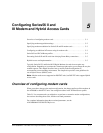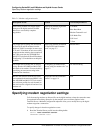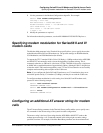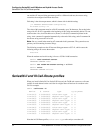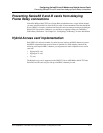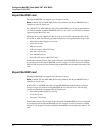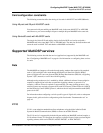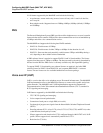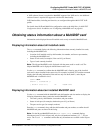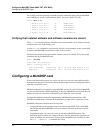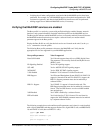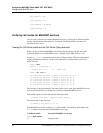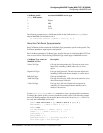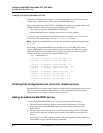
Configuring MultiDSP Cards (MAX TNT, APX 8000)
Supported MultiDSP services
APX 8000/MAX TNT/DSLTNT Physical Interface Configuration Guide Preliminary May 9, 2000 6-3
Card configuration constraints
The following constraints affect the mixing of slot cards in MAX TNT and APX 8000 units.
Using 48-port and 96-port MultiDSP cards
You cannot mix 48-port and 96-port MultiDSP cards in the same MAX TNT or APX 8000
unit. However, you can use multiple 48-port or multiple 96-port MultiDSP in the same unit.
Using Series56 cards with MultiDSP cards
The single-slot Series56 II card and the single-slot Series56 III card can be used with a
MultiDSP card in the same MAX TNT or APX 8000 unit. The dual-slot Series56 modem card
cannot be used in a MAX TNT unit that has a MultiDSP card installed.
Supported MultiDSP services
The following sections describe the services (applications) supported by the MultiDSP card.
See “Configuring a MultiDSP card” on page 6-6 for information on configuring these services
in a unit.
Data
The MultiDSP card supports calls made through analog modems that comply with standards
such as V.90, and digital calls made through the High-Level Data Link Control (HDLC)
protocol. Digital calls can come from an ISDN Primary Rate Interface (PRI) line, a Signaling
System 7 (SS7) network, or an E1 line with R2 signaling.
Although analog modem service is enabled by default, additional software licenses might be
required to support digital calls that use particular signaling schemes or protocols. For
example, a software license is required to support the R2 call setup signaling protocol. Also,
software licenses are required to support the Ascend SS7 Gateway Control Protocol (ASGCP)
and the IP Device Control (IPDC) protocol, which are the call setup intermachine trunk (IMT)
protocols for SS7.
For information about configuring a unit for specific types of digital calls, refer to subsequent
chapters in this guide and to the configuration guides listed under “Documentation set” on
page xxi.
V.110
V.110 is a rate adaption standard that allows telephones using the digital cellular Global
System for Mobile Communication (GSM) to connect to an ISDN network.
The V.110 service is supported by both the 48-port and 96-port MultiDSP card and requires a
V.110 software license. V.110 support also requires a software license for the associated digital
signaling scheme, which can be PRI, R2, ASGCP IMT/SS7, or IPDC IMT/SS7.



